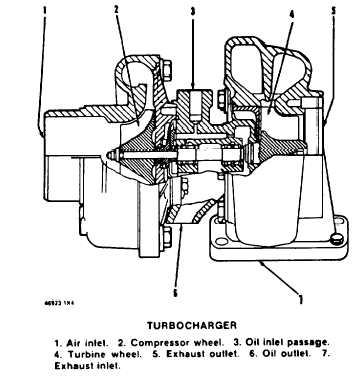AIR INLET AND EXHAUST SYSTEM
TURBOCHARGER
The turbocharger is installed on theexhaust mani-
fold. All the exhaust gases from the engine go
through the turbocharger.
The exhaust gases go through the blades of the
turbine wheel. This causes the turbine wheel and
compressor wheel to turn which causes a compres-
sion of the inlet air.
When the load on the engine goes up more fuel is
put into the engine. This makes more exhaust gases
and will cause the turbine and compressor wheels of
the turbocharger to turn faster. As the turbocharger
turns faster, it gives more inlet air and makes it
possible for the engine to burn more fuel and will give
the engine more power.
Maximum rpm of the turbocharger is controlled
by the fuel or rack setting. the high idle speed setting
and the height above sea level at which the engine is
operated.
If the high idle rpm or the fuel system setting is
higher than given in the FUEL SETTING INFOR-
MATION (for the height above sea level at
which the engine is operated), there can be
damage to engine or turbocharger parts.
SYSTEMS OPERATION
TM 5-3805-263-14&P-2
The bearings for the turbocharger use engine oil
under pressure for lubrication. The oil comes in
through the oil inlet port and goes through passages
in the center section for lubrication of the bearings.
Oil from the turbocharger goes out through the oil
outlet port in the bottom of the center section and
goes back to the engine lubrication system.
The fuel system adjustment is done at the factory
for a specific engine application. The governor hous-
ing and turbocharger are sealed to prevent changes
in the adjustment of the fuel or rack setting and the
high idle speed setting.
TIMING GEARS
The timing gears are at the front of the cylinder
block. Their cover is the housing for the timing gears.
The timing gears keep the rotation of the crankshaft,
camshaft and fuel injection pump in the correct rela-
tion to each other. The timing gears are driven by the
crankshaft gear.
1-13



